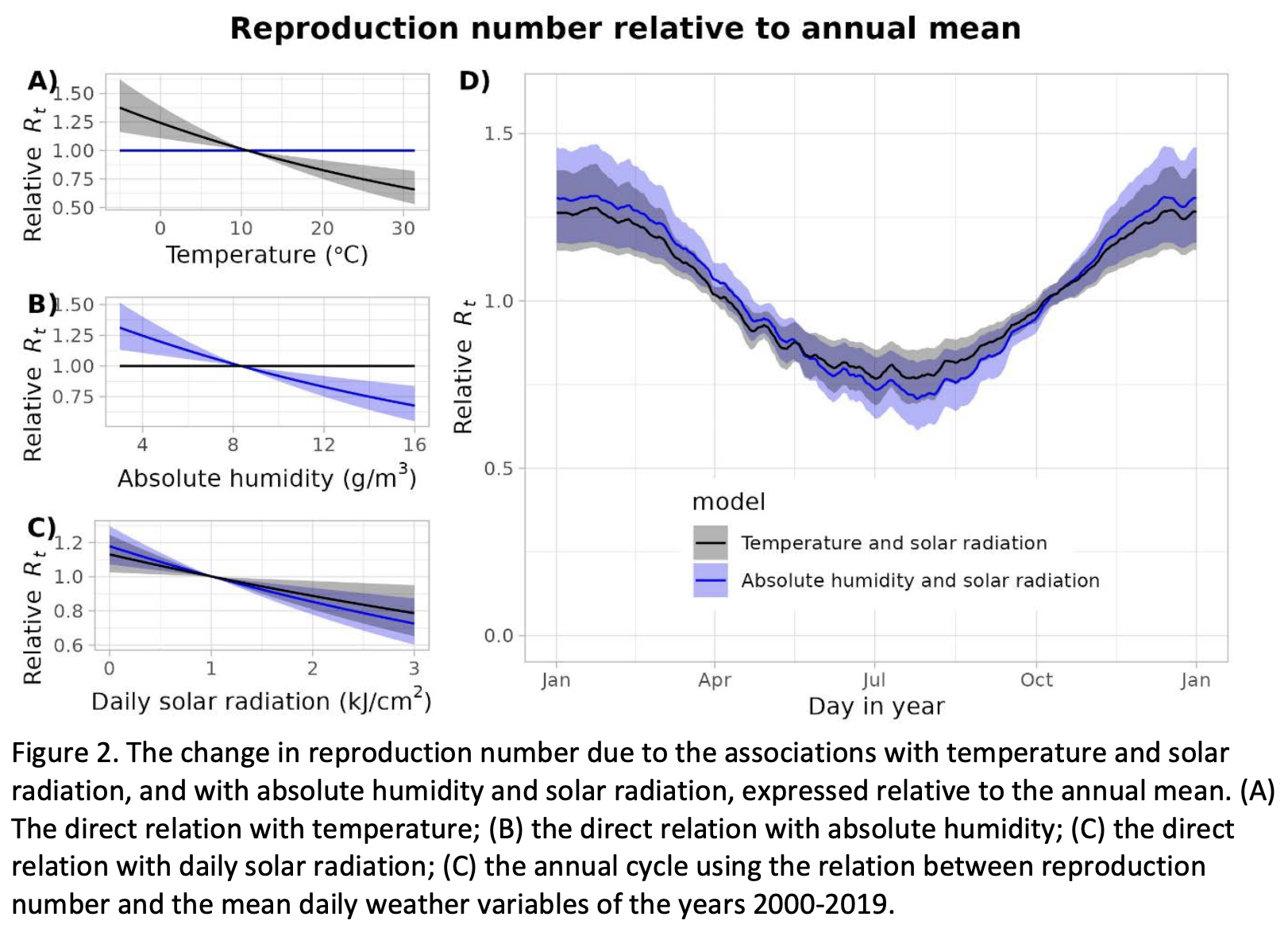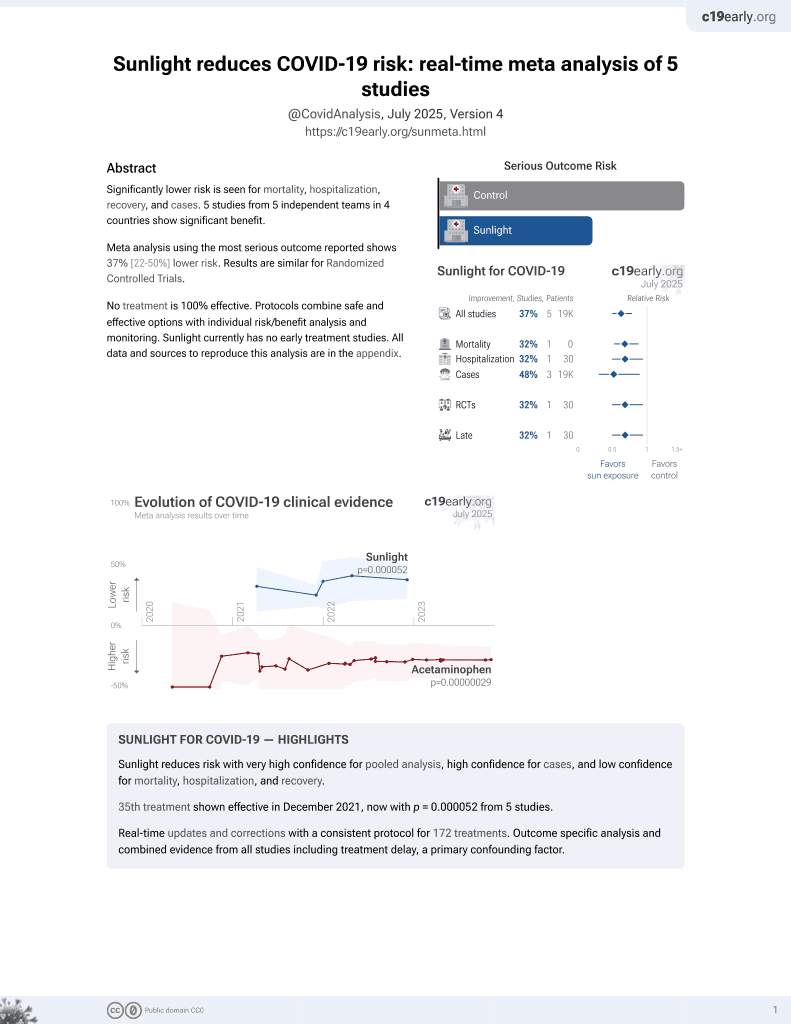
Seasonal variation in SARS-CoV-2 transmission in the Netherlands, 2020-2022: statistical evidence for an inverse association with solar radiation and temperature
et al., medRxiv, doi:10.1101/2024.11.28.24318154, Nov 2024
Sunlight for COVID-19
35th treatment shown to reduce risk in
December 2021, now with p = 0.000052 from 5 studies.
No treatment is 100% effective. Protocols
combine treatments.
6,300+ studies for
210+ treatments. c19early.org
|
Retrospective ecological time-series study of 109 consecutive weekly SARS-CoV-2 Rt estimates in the Netherlands showing significantly lower transmission with higher solar radiation and temperature, corresponding to a 70-90% higher reproduction number in winter compared to summer after adjustments.
Klinkenberg et al., 29 Nov 2024, Netherlands, preprint, 4 authors, study period 22 February, 2020 - 29 March, 2022.
Contact: don.klinkenberg@rivm.nl.
Seasonal variation in SARS-CoV-2 transmission in the Netherlands, 2020-2022: statistical evidence for an inverse association with solar radiation and temperature
doi:10.1101/2024.11.28.24318154
In temperate regions, respiratory viruses such as SARS-CoV-2 are better transmitted in winter than in summer. Understanding how the weather is associated with SARS-CoV-2 transmissibility can enhance projections of COVID-19 incidence and improve estimation of the effectiveness of control measures. During the pandemic, transmissibility was tracked by the reproduction number R t . This study aims to determine whether information about the daily temperature, absolute humidity, and solar radiation improves predictions of R t in the Netherlands from 2020 to 2022, and to quantify the relationship between R t and daily weather data. We conducted a regression analysis, accounting for immunity from vaccination and previous infection, higher transmissibility of new variants, and changes in contact behaviour due to control measures. Results show a linear association between logR t and daily solar radiation and temperature, indicating a ratio of R t in Winter versus Summer of 1.7 (95% CI, 1.4-2.1). The possibility that this association arises from unrelated seasonal patterns was dismissed, as weather data from earlier years provided poorer fits with only small effect sizes. This suggests a causal relationship of solar radiation and temperature with SARS-CoV-2 transmissibility, enhancing confidence in using this relationship for short-term predictions and other epidemiological analyses.
References
Atchison, Tam, Hajat, Van Pelt, Cowden et al., Temperaturedependent transmission of rotavirus in Great Britain and The Netherlands, Proc Biol Sci, doi:10.1098/rspb.2009.1755
Babin, Use of Weather Variables in SARS-CoV-2 Transmission Studies, Int J Infect Dis, doi:10.1016/j.ijid.2020.09.032
Bulfone, Malekinejad, Rutherford, Razani, Outdoor Transmission of SARS-CoV-2 and Other Respiratory Viruses: A Systematic Review, J Infect Dis, doi:10.1093/infdis/jiaa742
Burnham, Anderson, Burnham, Model selection and multimodel inference : a practical information-theoretic approach
Bussemakers, Stappers, Kroese, Van Den Putte, De Bruin, Psychosocial determinants of handwashing and physical distancing behaviour during the COVID-19 pandemic in the Netherlands: A longitudinal analysis, Br J Health Psychol, doi:10.1111/bjhp.12755
Campbell, Archer, Laurenson-Schafer, Jinnai, Konings et al., Increased transmissibility and global spread of SARS-CoV-2 variants of concern as at June 2021, Euro Surveill, doi:10.2807/1560-7917.ES.2021.26.24.2100509
Cook, Influential observations in linear regression, Journal of the American Statistical Association, doi:10.1080/01621459.1979.10481634
Gostic, Mcgough, Baskerville, Abbott, Joshi et al., Practical considerations for measuring the effective reproductive number, Rt. PLoS Comput Biol, doi:10.1371/journal.pcbi.1008409
Hale, Angrist, Goldszmidt, Kira, Petherick et al., A global panel database of pandemic policies (Oxford COVID-19 Government Response Tracker), Nat Hum Behav, doi:10.1038/s41562-021-01079-8
Huiberts, De Gier, Hoeve, De Melker, Hahne et al., Vaccine effectiveness of primary and booster COVID-19 vaccinations against SARS-CoV-2 infection in the Netherlands from July 12, 2021 to June 6, 2022: A prospective cohort study, Int J Infect Dis, doi:10.1016/j.ijid.2023.04.401
Kissler, Tedijanto, Goldstein, Grad, Lipsitch, Projecting the transmission dynamics of SARS-CoV-2 through the postpandemic period, Science, doi:10.1126/science.abb5793
Limaheluw, Dollmann, Folpmers, Beltran Beut, Lazarakou et al., Associations between meteorological factors and COVID-19: a global scoping review, Front Public Health, doi:10.3389/fpubh.2024.1183706
Lowen, Mubareka, Steel, Palese, Influenza virus transmission is dependent on relative humidity and temperature, PLoS Pathog, doi:10.1371/journal.ppat.0030151
Ma, Pei, Shaman, Dubrow, Chen, Role of meteorological factors in the transmission of SARS-CoV-2 in the United States, Nat Commun, doi:10.1038/s41467-021-23866-7
Martinez, The calendar of epidemics: Seasonal cycles of infectious diseases, PLoS Pathog, doi:10.1371/journal.ppat.1007327
Metcalf, Walter, Wesolowski, Buckee, Shevliakova et al., Identifying climate drivers of infectious disease dynamics: recent advances and challenges ahead, Proc Biol Sci, doi:10.1098/rspb.2017.0901
Moriyama, Hugentobler, Iwasaki, Seasonality of Respiratory Viral Infections, Annu Rev Virol, doi:10.1146/annurev-virology-012420-022445
Paireau, Charpignon, Larrieu, Calba, Hoze et al., Impact of non-pharmaceutical interventions, weather, vaccination, and variants on COVID-19 transmission across departments in France, BMC Infect Dis, doi:10.1186/s12879-023-08106-1
Sajadi, Habibzadeh, Vintzileos, Shokouhi, Miralles-Wilhelm et al., Temperature, Humidity, and Latitude Analysis to Estimate Potential Spread and Seasonality of Coronavirus Disease 2019 (COVID-19), JAMA Netw Open, doi:10.1001/jamanetworkopen.2020.11834
Sera, Armstrong, Abbott, Meakin, O'reilly et al., A cross-sectional analysis of meteorological factors and SARS-CoV-2 transmission in 409 cities across 26 countries, Nat Commun, doi:10.1038/s41467-021-25914-8
Te Beest, Van Boven, Hooiveld, Van Den Dool, Wallinga, Driving factors of influenza transmission in the Netherlands, Am J Epidemiol, doi:10.1093/aje/kwt132
Wagatsuma, Association of Ambient Temperature and Absolute Humidity with the Effective Reproduction Number of COVID-19 in Japan, Pathogens, doi:10.3390/pathogens12111307
Wallinga, Teunis, Different epidemic curves for severe acute respiratory syndrome reveal similar impacts of control measures, Am J Epidemiol, doi:10.1093/aje/kwh255
Wei, Dong, Fan, Xu, Tang et al., A narrative review on the role of temperature and humidity in COVID-19: Transmission, persistence, and epidemiological evidence, Eco Environ Health, doi:10.1016/j.eehl.2022.04.006
Wood, Generalized additive models : an introduction with R
Wu, Goldstein, Ho, Yang, Nishiura et al., Excess mortality associated with influenza A and B virus in Hong Kong, 1998-2009, J Infect Dis, doi:10.1093/infdis/jis628
Xu, Rahmandad, Gupta, Digennaro, Ghaffarzadegan et al., Weather, air pollution, and SARS-CoV-2 transmission: a global analysis, Lancet Planet Health, doi:10.1016/S2542-5196(21)00202-3
DOI record:
{
"DOI": "10.1101/2024.11.28.24318154",
"URL": "https://doi.org/10.1101/2024.11.28.24318154",
"abstract": "<jats:title>ABSTRACT</jats:title>\n <jats:p>In temperate regions, respiratory viruses such as SARS-CoV-2 are better transmitted in winter than in summer. Understanding how the weather is associated with SARS-CoV-2 transmissibility can enhance projections of COVID-19 incidence and improve estimation of the effectiveness of control measures. During the pandemic, transmissibility was tracked by the reproduction number <jats:italic>R</jats:italic>\n <jats:sub>\n <jats:italic>t</jats:italic>\n </jats:sub>. This study aims to determine whether information about the daily temperature, absolute humidity, and solar radiation improves predictions of <jats:italic>R</jats:italic>\n <jats:sub>\n <jats:italic>t</jats:italic>\n </jats:sub> in the Netherlands from 2020 to 2022, and to quantify the relationship between <jats:italic>R</jats:italic>\n <jats:sub>\n <jats:italic>t</jats:italic>\n </jats:sub> and daily weather data. We conducted a regression analysis, accounting for immunity from vaccination and previous infection, higher transmissibility of new variants, and changes in contact behaviour due to control measures. Results show a linear association between log<jats:italic>R</jats:italic>\n <jats:sub>\n <jats:italic>t</jats:italic>\n </jats:sub> and daily solar radiation and temperature, indicating a ratio of <jats:italic>R</jats:italic>\n <jats:sub>\n <jats:italic>t</jats:italic>\n </jats:sub> in Winter versus Summer of 1.7 (95% CI, 1.4-2.1). The possibility that this association arises from unrelated seasonal patterns was dismissed, as weather data from earlier years provided poorer fits with only small effect sizes. This suggests a causal relationship of solar radiation and temperature with SARS-CoV-2 transmissibility, enhancing confidence in using this relationship for short-term predictions and other epidemiological analyses.</jats:p>",
"accepted": {
"date-parts": [
[
2025,
7,
10
]
]
},
"author": [
{
"ORCID": "https://orcid.org/0000-0002-9449-6873",
"affiliation": [],
"authenticated-orcid": false,
"family": "Klinkenberg",
"given": "Don",
"sequence": "first"
},
{
"affiliation": [],
"family": "Backer",
"given": "Jantien",
"sequence": "additional"
},
{
"affiliation": [],
"family": "Reusken",
"given": "Chantal",
"sequence": "additional"
},
{
"affiliation": [],
"family": "Wallinga",
"given": "Jacco",
"sequence": "additional"
}
],
"container-title": [],
"content-domain": {
"crossmark-restriction": false,
"domain": []
},
"created": {
"date-parts": [
[
2024,
11,
29
]
],
"date-time": "2024-11-29T18:45:20Z",
"timestamp": 1732905920000
},
"deposited": {
"date-parts": [
[
2025,
7,
12
]
],
"date-time": "2025-07-12T10:30:21Z",
"timestamp": 1752316221000
},
"group-title": "Epidemiology",
"indexed": {
"date-parts": [
[
2025,
7,
12
]
],
"date-time": "2025-07-12T11:10:07Z",
"timestamp": 1752318607733,
"version": "3.41.2"
},
"institution": [
{
"name": "medRxiv"
}
],
"is-referenced-by-count": 2,
"issued": {
"date-parts": [
[
2024,
11,
29
]
]
},
"license": [
{
"URL": "http://creativecommons.org/licenses/by/4.0/",
"content-version": "vor",
"delay-in-days": 0,
"start": {
"date-parts": [
[
2024,
11,
29
]
],
"date-time": "2024-11-29T00:00:00Z",
"timestamp": 1732838400000
}
}
],
"link": [
{
"URL": "https://syndication.highwire.org/content/doi/10.1101/2024.11.28.24318154",
"content-type": "unspecified",
"content-version": "vor",
"intended-application": "similarity-checking"
}
],
"member": "246",
"original-title": [],
"posted": {
"date-parts": [
[
2024,
11,
29
]
]
},
"prefix": "10.1101",
"published": {
"date-parts": [
[
2024,
11,
29
]
]
},
"publisher": "Cold Spring Harbor Laboratory",
"reference": [
{
"DOI": "10.1371/journal.ppat.1007327",
"doi-asserted-by": "publisher",
"key": "2025071203301164000_2024.11.28.24318154v2.1"
},
{
"DOI": "10.1098/rspb.2017.0901",
"doi-asserted-by": "publisher",
"key": "2025071203301164000_2024.11.28.24318154v2.2"
},
{
"DOI": "10.1093/aje/kwt132",
"doi-asserted-by": "publisher",
"key": "2025071203301164000_2024.11.28.24318154v2.3"
},
{
"DOI": "10.1371/journal.ppat.0030151",
"doi-asserted-by": "publisher",
"key": "2025071203301164000_2024.11.28.24318154v2.4"
},
{
"DOI": "10.3389/fpubh.2024.1183706",
"doi-asserted-by": "publisher",
"key": "2025071203301164000_2024.11.28.24318154v2.5"
},
{
"DOI": "10.1146/annurev-virology-012420-022445",
"doi-asserted-by": "publisher",
"key": "2025071203301164000_2024.11.28.24318154v2.6"
},
{
"DOI": "10.1098/rspb.2009.1755",
"doi-asserted-by": "publisher",
"key": "2025071203301164000_2024.11.28.24318154v2.7"
},
{
"DOI": "10.1093/infdis/jiaa742",
"doi-asserted-by": "publisher",
"key": "2025071203301164000_2024.11.28.24318154v2.8"
},
{
"DOI": "10.1016/j.ijid.2020.09.032",
"doi-asserted-by": "publisher",
"key": "2025071203301164000_2024.11.28.24318154v2.9"
},
{
"DOI": "10.1001/jamanetworkopen.2020.11834",
"doi-asserted-by": "publisher",
"key": "2025071203301164000_2024.11.28.24318154v2.10"
},
{
"DOI": "10.1126/science.abb5793",
"doi-asserted-by": "publisher",
"key": "2025071203301164000_2024.11.28.24318154v2.11"
},
{
"DOI": "10.1038/s41467-021-25914-8",
"doi-asserted-by": "publisher",
"key": "2025071203301164000_2024.11.28.24318154v2.12"
},
{
"DOI": "10.1038/s41467-021-23866-7",
"doi-asserted-by": "publisher",
"key": "2025071203301164000_2024.11.28.24318154v2.13"
},
{
"DOI": "10.3390/pathogens12111307",
"doi-asserted-by": "publisher",
"key": "2025071203301164000_2024.11.28.24318154v2.14"
},
{
"DOI": "10.1016/j.eehl.2022.04.006",
"doi-asserted-by": "publisher",
"key": "2025071203301164000_2024.11.28.24318154v2.15"
},
{
"DOI": "10.1186/s12879-023-08106-1",
"doi-asserted-by": "publisher",
"key": "2025071203301164000_2024.11.28.24318154v2.16"
},
{
"DOI": "10.1016/S2542-5196(21)00202-3",
"doi-asserted-by": "publisher",
"key": "2025071203301164000_2024.11.28.24318154v2.17"
},
{
"key": "2025071203301164000_2024.11.28.24318154v2.18",
"unstructured": "Covid-19 reproductiegetal. (2023 ed, National Institute for Public Health and the Environment (RIVM)."
},
{
"DOI": "10.1093/aje/kwh255",
"doi-asserted-by": "publisher",
"key": "2025071203301164000_2024.11.28.24318154v2.19"
},
{
"DOI": "10.1371/journal.pcbi.1008409",
"doi-asserted-by": "publisher",
"key": "2025071203301164000_2024.11.28.24318154v2.20"
},
{
"key": "2025071203301164000_2024.11.28.24318154v2.21",
"unstructured": "Covid-19 rapportage van SARS-CoV-2 varianten in Nederland via de aselecte steekproef van RT-PCR positieve monsters in de nationale kiemsurveillance. (ed. N.I.f.P.H.a.t.E. (RIVM)), 2024 ed. Bilthoven, The Netherlands, National Institute for Public Health and the Environment (RIVM)."
},
{
"DOI": "10.2807/1560-7917.ES.2021.26.24.2100509",
"doi-asserted-by": "publisher",
"key": "2025071203301164000_2024.11.28.24318154v2.22"
},
{
"key": "2025071203301164000_2024.11.28.24318154v2.23",
"unstructured": "COVID-19 besmettelijke personen per dag. (2021 ed, National Institute for Public Health and the Environment (RIVM)."
},
{
"key": "2025071203301164000_2024.11.28.24318154v2.24",
"unstructured": "Covid-19 Cumulatieve opkomst voor tenminste één COVID-19 vaccinatie, vaccinatiegraad basisserie, vaccinatiegraad herhaalprik tegen corona binnen de najaarsronde 2022 naar gemeente en veiligheidsregio per geboortecohort per week. (ed. N.I.f.P.H.a.t.E. (RIVM)), 2022 ed. Bilthoven, The Netherlands, National Institute for Public Health and the Environment (RIVM)."
},
{
"DOI": "10.1016/j.ijid.2023.04.401",
"doi-asserted-by": "publisher",
"key": "2025071203301164000_2024.11.28.24318154v2.25"
},
{
"DOI": "10.1080/01621459.1979.10481634",
"doi-asserted-by": "publisher",
"key": "2025071203301164000_2024.11.28.24318154v2.26"
},
{
"key": "2025071203301164000_2024.11.28.24318154v2.27",
"unstructured": "Daggegevens van het weer in Nederland. (ed. R.N.M.I. (KNMI)), 2022 ed, Royal Netherlands Meteorological Institute (KNMI)."
},
{
"DOI": "10.1093/infdis/jis628",
"doi-asserted-by": "publisher",
"key": "2025071203301164000_2024.11.28.24318154v2.28"
},
{
"DOI": "10.1038/s41562-021-01079-8",
"doi-asserted-by": "publisher",
"key": "2025071203301164000_2024.11.28.24318154v2.29"
},
{
"first-page": "476",
"key": "2025071203301164000_2024.11.28.24318154v2.30",
"volume": "xx",
"volume-title": "Generalized additive models : an introduction with R",
"year": "2017"
},
{
"key": "2025071203301164000_2024.11.28.24318154v2.31",
"unstructured": "Burnham, K.P. , Anderson, D.R. & Burnham, K.P. 2002 Model selection and multimodel inference : a practical information-theoretic approach. 2nd ed. New York, Springer; xxvi, 488 p. p."
},
{
"DOI": "10.1111/bjhp.12755",
"doi-asserted-by": "publisher",
"key": "2025071203301164000_2024.11.28.24318154v2.32"
}
],
"reference-count": 32,
"references-count": 32,
"relation": {},
"resource": {
"primary": {
"URL": "http://medrxiv.org/lookup/doi/10.1101/2024.11.28.24318154"
}
},
"score": 1,
"short-container-title": [],
"short-title": [],
"source": "Crossref",
"subject": [],
"subtitle": [],
"subtype": "preprint",
"title": [
"Seasonal variation in SARS-CoV-2 transmission in the Netherlands, 2020-2022: statistical evidence for an inverse association with solar radiation and temperature"
],
"type": "posted-content"
}
